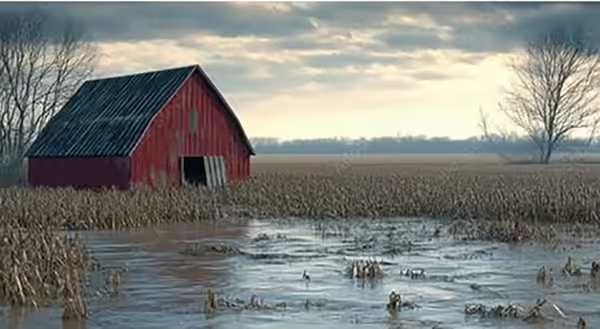
Draining excess water from farm fields in Illinois is vital to food and renewable fuel production. However, the lack of adequate farm drainage is a serious problem. Many older farm drainage systems are still in place but are past their viable economic use value due to being obsolete, inefficient, and deteriorated.
A farm drainage system is like a neighborhood in a city with connecting streets through which traffic flows. The street by your house is small, but it connects to a larger road, which connects to a highway that leads to a freeway. Water similarly moves through the drainage system. Tiles in the field are three or four inches in diameter, connecting larger tiles to the final outlet that leads to the drainage ditch. Some pipes near the outlet can be eighteen to thirty inches in diameter or more. Due to obsolescence, in many cases, this water “traffic” drainage system does a poor job of effectively draining excess water from farm fields.
Some farms have a tax-supported district tile main to help create a pathway to a ditch, but many do not. Tax-supported and private mains often operate above capacity and cannot add more capacity. Building cooperation to construct a private tile main is challenging, as neighbors disagree about repairing drainage systems, and support for higher taxes for improvements is difficult to obtain.
The Case Study – A Look at Improving a Drain Tile Outlet
The ‘2019 Drainage Tile Outlet Replacement Project’ examines the impact of a joint private tile main and how the effort impacted profitability. The 360-acre subject farm is divided by a large drainage district ditch constructed around the early 1900s. Drainage from the western two-thirds of the subject farm and the four farms to the west flows east toward the drainage ditch. The case study results are not perfect, as the farming practices and crop rotations changed during the years of data collection.
Obstructions in the mains occurred where the tile mains flowed under a major railroad and state highway before flowing into the large district drainage ditch. These 1930s-era tile mains under the railroad were crushed and undersized initially. There was no recorded agreement for the railroad and state to repair the tiles under their right-of-way. The successful completion of the new project allowed the railroad track to be avoided and the four tile mains to be replaced with one larger new tile main. Avoiding the boring of a new tile under the railroad and highway saved over $100,000 in installation costs.
Farms Draining Through the Subject Farm
The farms in the drainage watershed are Class B-type farms. These farms have good, but not the best, soils because their soil type makes them inherently difficult to drain.
Farm-A was pattern tiled back in the 1970s with tie lines spaced farther apart vs. modern standards. The drainage from Farm-A was restricted due to the damage to the tile main flowing across the subject farm from the crushing of the tile under the railroad. The water from Farm-A rose to the surface rather than remaining in its channel, which slowed the drainage rate.
Farm-B had no modern drainage tile system and did not provide yields for this study, but the owners enthusiastically supported participating in the project. Farm-C sold shortly after project completion. The existing tile on Farm-C was in deplorable condition, and the new owner installed a new complete drainage system after the 2019 Drainage Tile Outlet Replacement Project was finished. The original Farm-C tile system was in poor condition prior to the project installation. Drainage from neighboring fields was severely restricted, causing blowouts on the Subject Farm and resulting in significant crop damage and reduced yields across all affected farms. These farms experienced persistent saturation and flooding.
Early Results
The study looks at yield results from all the involved farms compared to the county average for profitability. Given the variable factors across the case study farms, the findings must be interpreted cautiously. The total cost for the 1.1-mile-long tile main to drain the 451 project acres was $250 per acre.
Corn yields were analyzed for the five-year periods before and after the project, showing, on average, a 13.7% yield improvement compared to the county average yield. The average corn yield post-project on corn was 249 bushels per acre across all acres. The additional yield with a selected corn price of $4.50 per bushel equates to an average $132 extra revenue per acre per year. With the completion of the new pattern tile system, Farm-C had the highest yield improvements on corn. Offsetting the new pattern tile system on Farm-C still indicates a revenue improvement of $113 per acre per year for the project, making the payoff period less than 2.5 years for corn.
Soybean yields showed an average 10.5% increase during the five years preceding and following the project. The average yield on the farms was 74.4 bushels per acre per year post-project. At $10.50 per bushel price, the increase in revenue equates to $83.6 per acre per year. The data suggests that soybeans would pay for themselves in about three years. A corn/soybean rotation would recover costs in less than three production years. These results indicate a very positive outcome for the 2019 Drainage Tile Outlet Replacement Project.